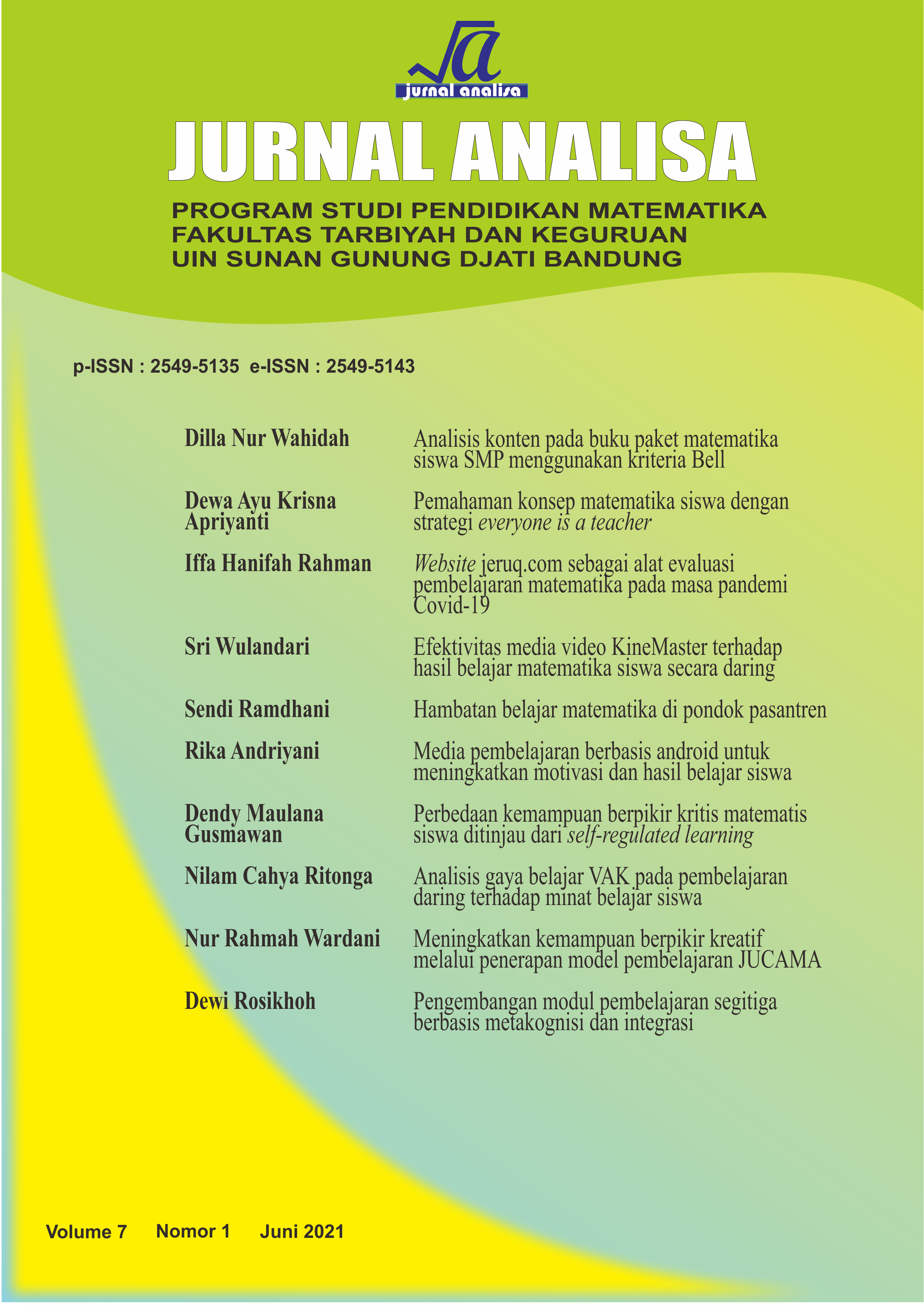Pemahaman konsep matematika siswa dengan strategi everyone is a teacher here
DOI:
https://doi.org/10.15575/ja.v7i1.8529Keywords:
Pemahaman konsep, Matematika, Strategi Everyone is a Teacher HereAbstract
Tujuan dari penelitian ini untuk meningkatkan pemahaman konsep matematika siswa melalui penerapan model pembelajaran kooperatif dengan strategi Everyone is a Teacher Here di kelas VIII E SMPN 4 Sukasada tahun ajaran 2019/2020 karena memahami konsep matematika merupakan hal penting serta menjadi kemampuan dasar yang mesti dikuasai siswa supaya dapat mengembangkan kemampuan berpikir matematika tingkat tinggi, namun faktanya kemampuan pemahaman konsep matematika siswa masih rendah. Jenis pene-litian ini adalah penelitian tindakan kelas. Instrumen penelitian ini berupa tes pemahaman konsep berbetuk soal uraian dengan 6 pertanyaan di masing-masing siklus dan non tes berupa angket untuk mengetahui tanggapan siswa. Setelah dilaksanakan dengan 3 siklus didapatkan hasil bahwa model pembelajaran kooperatif dengan strategi Everyone is a Teacher Here mampu meningkatkan pemahaman konsep matematika siswa serta siswa menanggapi dengan positif pembelajaran dengan menerapkan model ini.
Kata kunci: Pemahaman konsep, Matematika, Strategi Everyone is a Teacher Here
This study aims to improve students' understanding of mathematical concepts through the application of cooperative learning models with the Everyone is a Teacher Here strategy in VIII E class of SMPN 4 Sukasada academic year 2019/2020 because understanding mathematics concepts is important and becomes the basic ability that students must master to develop high-level mathematical thinking skills, but the fact is the ability to understand students' mathematical concepts is still low. This type of research is classroom action research. The instrument in this study was a test of understanding the concept of problem-solving questions consisting of 6 questions in each cycle and non-test in the form of a questionnaire to determine student responses. After being carried out with 3 cycles, the result is the cooperative learning model with Everyone is a Teacher Here strategy can improve students' understanding of mathematical concepts and students respond positively to learning by applying this model.
Keywords: Conceptual Understanding, Mathematics, Everyone is a Teacher Here Strategy
References
Budarsini, K. P., Suarsana, I. M., & Suparta, I. N. (2018). Model diskursus multi representasi dan kemampuan pemahaman konsep matematika siswa sekolah menegah pertama. Pythagoras: Jurnal Pendidikan Matematika, 13(2), 110–118. https://doi.org/10.21831/pg.v13i2.20047
Candiasa. (2010). Pengujian Instrumen Penelitian Disertai Aplikasi ITEMAN Dan BIGSTEPS.
Handayani, E. (2016). Pengaruh Penerapan Strategi Pembelajaran Everyone is a Teacher Here dengan metode Mind Map terhadap pemahaman konsep Matematis peserta didik kelas VII Mts Negeri 01 Kotabumi tahun ajaran 2015/2016.
Hendrayana, A. (2017). Pengaruh pembelajaran pendekatan rigorous mathematical thinking (RMT) terhadap pemahaman konseptual matematis siswa SMP. Jurnal Riset Pendidikan Matematika. https://doi.org/10.21831/jrpm.v4i2.15385
Kasbolah, K. (1988). A syllabus for the course in teaching/learning strategies for students of English education in Indonesia. In ProQuest Dissertations and Theses.
Kesumawati, N. (2013). Delta-Pi: Jurnal Matematika dan Pendidikan Matematika Vol. 2, No. 1, April 2013 ISSN 2089-855X. KEMAMPUAN KOMUNIKASI DAN BERPIKIR LOGIS MATEMATIK SERTA KEMANDIRIAN BELAJAR: Eksperimen Terhadap Siswa SMA Menggunakan Pembelajaran Berbasis Masalah Dan Strategi Think-Talk-Write.
Lasmanah, A. (2017). Peningkatan Hasil Belajar Matematika Siswa Melalui Model Kooperatif Teknik Think Pair Share (Tps) (Penelitian Tindakan Kelas Terhadap Siswa Kelas Vii-a Smpn Sukasari Sumedangâ€. Jurnal Analisa, 2(3), 18. https://doi.org/10.15575/ja.v2i3.1221
Made Suarsana, I., Widiasih, N. P. S., & Nengah Suparta, I. (2018). The effect of brain based learning on second grade junior students’ mathematics conceptual understanding on polyhedron. Journal on Mathematics Education.
Matematika, J. D., Matematika, J., & Negeri, U. (2014). Pembelajaran Matematika Sekarang dan yang akan Datang Berbasis Karakter. Didaktik Matematika, 1(2), 30–42. https://doi.org/10.24815/jdm.v1i2.2059
NCTM. (2000). Principles and Standards for School Mathematics. In School Science and Mathematics.
Rahmawati, I., & Fahmi, S. N. (2014). IMPLEMENTASI METODE EVERYONE IS TEACHER HERE PADA PEMBELAJARAN TEMATIK TERINTEGRASI KELAS IV SEMESTER II SUBTEMA SIKAP KEPAHLAWANAN SD PETOMPON 01 SEMARANG. Malih Peddas (Majalah Ilmiah Pendidikan Dasar). https://doi.org/10.26877/malihpeddas.v4i1.530
Silberman, M. (1996). Introduction to active learning. Active Learning: 101 Strategies to Teach Any Subject.
Suharsimi;, A. (2013). Dasar-Dasar Evaluasi Pendidikan. In Jakarta: Bumi Aksara.
Suherman. (2015). Kreativitas Siswa Dalam Memecahkan Masalah Matematika Materi Pola Bilangan Dengan Pendekatan Matematika Realistik (PMR). Al-Jabar.
Zahid, A., Susilawati, W., Jihad, A., & Maryono, I. (2013). Penerapan Teknik Ikonik terhadap Kemampuan Pemahaman Matematika Siswa pada Pembelajaran Matematika Pokok Bahasan Pecahan. Jurnal Analisa, 1(1), 12–19. https://doi.org/10.15575/ja.v1i1.2891
Downloads
Published
Issue
Section
License
Authors who publish in Jurnal Analisa agree to the following terms:
1. Authors retain copyright and grant the journal right of first publication with the work simultaneously licensed under a Attribution-ShareAlike 4.0 International (CC BY-SA 4.0) License that allows others to share the work with an acknowledgment of the work's authorship and initial publication in this journal.
2. Authors are able to enter into separate, additional contractual arrangements for the non-exclusive distribution of the journal's published version of the work (e.g., post it to an institutional repository or publish it in a book), with an acknowledgment of its initial publication in this journal.
3.Authors are permitted and encouraged to post their work online (e.g., in institutional repositories or on their website) prior to and during the submission process, as it can lead to productive exchanges, as well as earlier and greater citation of published work (See The Effect of Open Access).
